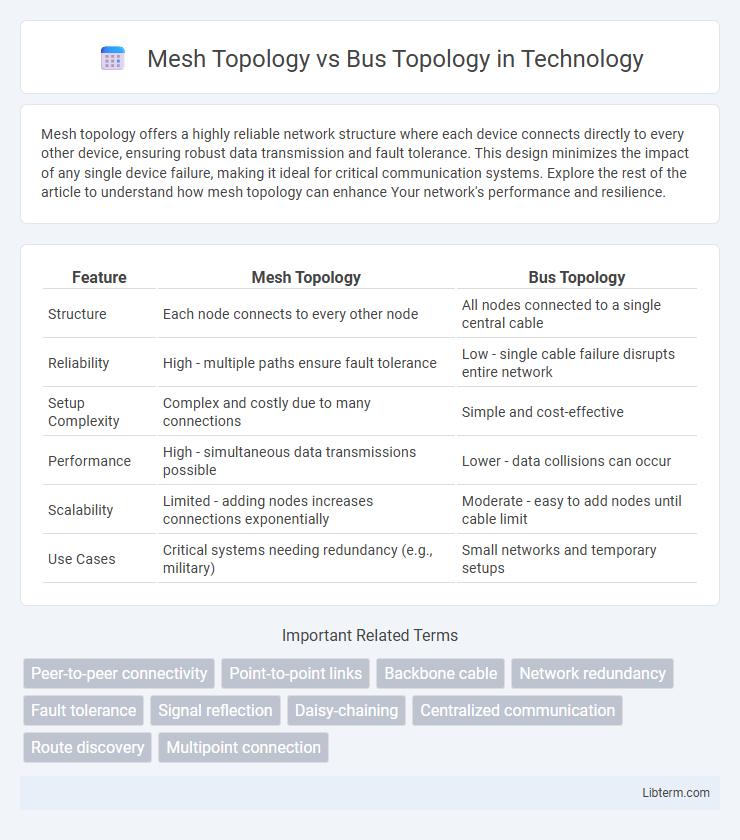Mesh topology offers a highly reliable network structure where each device connects directly to every other device, ensuring robust data transmission and fault tolerance. This design minimizes the impact of any single device failure, making it ideal for critical communication systems. Explore the rest of the article to understand how mesh topology can enhance Your network's performance and resilience.
Table of Comparison
| Feature | Mesh Topology | Bus Topology |
|---|---|---|
| Structure | Each node connects to every other node | All nodes connected to a single central cable |
| Reliability | High - multiple paths ensure fault tolerance | Low - single cable failure disrupts entire network |
| Setup Complexity | Complex and costly due to many connections | Simple and cost-effective |
| Performance | High - simultaneous data transmissions possible | Lower - data collisions can occur |
| Scalability | Limited - adding nodes increases connections exponentially | Moderate - easy to add nodes until cable limit |
| Use Cases | Critical systems needing redundancy (e.g., military) | Small networks and temporary setups |
Introduction to Network Topologies
Mesh topology features a decentralized network structure where each device connects directly to every other device, ensuring high redundancy and fault tolerance. Bus topology uses a single central cable, or bus, to which all devices connect, making it easy to implement but prone to data collisions and network failure if the bus cable is damaged. Understanding these fundamental differences aids in selecting the optimal network design based on scalability, reliability, and maintenance requirements.
What is Mesh Topology?
Mesh topology is a network configuration where each node connects directly to every other node, ensuring high redundancy and fault tolerance. This setup allows for multiple data paths, minimizing the risk of network failure and improving communication reliability. Mesh topology is ideal for environments requiring robust, uninterrupted connectivity, such as in critical infrastructure and large scale wireless networks.
What is Bus Topology?
Bus topology is a network configuration where all devices are connected to a single central cable, known as the bus or backbone, facilitating data transmission in a linear fashion. This topology is simple to implement and cost-effective for small networks but can lead to data collisions and network failure if the central cable is damaged. Unlike mesh topology, which provides multiple redundant paths between devices, bus topology lacks fault tolerance and scalability.
Architecture and Design Differences
Mesh topology features a decentralized architecture where each node connects directly to every other node, ensuring high redundancy and fault tolerance. Bus topology employs a single central cable, or bus, to which all network devices are attached, creating a linear and simpler design but increasing vulnerability to cable failure. The mesh design's complexity and higher cabling cost contrast with the bus topology's straightforward layout and easier installation.
Performance and Scalability Comparison
Mesh topology offers superior performance through dedicated point-to-point connections, reducing data collisions and enhancing network reliability, making it ideal for high-traffic environments. Bus topology experiences performance degradation as more devices are connected due to data collisions on the shared communication line, limiting its scalability. Mesh topology scales efficiently by adding nodes without significant impact on speed or reliability, while bus topology's scalability is constrained by bus length and increased signal interference.
Reliability and Fault Tolerance
Mesh topology offers superior reliability and fault tolerance by providing multiple redundant communication paths between devices, ensuring network functionality even if one or more connections fail. Bus topology relies on a single communication line, making it highly vulnerable to failures that can disrupt the entire network if the main cable is damaged. Consequently, mesh networks maintain continuous operation and minimize downtime, while bus networks face significant risks of complete network failure from a single point of fault.
Installation and Maintenance Considerations
Mesh topology installation requires extensive cabling and complex configuration due to its multiple connections between devices, increasing setup time and costs. Maintenance in mesh networks is simplified by redundancy, allowing data rerouting during failures without disrupting communication. Bus topology installation is straightforward and cost-effective with a single backbone cable but poses challenges in troubleshooting and maintenance since a failure in the main cable can disrupt the entire network.
Cost Analysis: Mesh vs Bus Topology
Mesh topology incurs higher costs due to extensive cabling and hardware requirements for every device to connect directly with all others, increasing installation and maintenance expenses. Bus topology offers a cost-effective solution with a single central cable shared by all devices, minimizing cabling complexity and reducing initial setup costs. However, bus topology may face higher long-term costs from potential network downtime and limitations in scalability compared to the robust and fault-tolerant mesh topology.
Use Cases and Practical Applications
Mesh topology excels in mission-critical environments like data centers and military communication systems due to its high redundancy and fault tolerance, ensuring continuous network uptime. Bus topology suits small, simple LANs or temporary networks where cost-efficiency and ease of installation are priorities, such as in early-stage prototyping or small office setups. Mesh networks handle heavy traffic and complex routing efficiently, while bus networks support straightforward, low-traffic scenarios with minimal cabling requirements.
Conclusion: Choosing the Right Topology
Choosing the right network topology depends on factors such as scalability, fault tolerance, and cost efficiency. Mesh topology offers high reliability and resilience through multiple redundant connections, making it ideal for critical systems requiring uninterrupted communication. Bus topology suits simpler, cost-sensitive applications with smaller networks but poses limitations in fault isolation and scalability.
Mesh Topology Infographic

 libterm.com
libterm.com